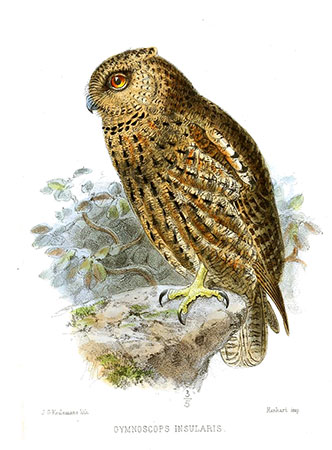
Fr: Petit-duc scieur
Ang: Seychelles Scops Owl - Bare-legged Scops Owl
All: Seychellen-Zwergohreule
Esp: Autillo de Seychelles
Ita: Assiolo delle Seychelles
Nd: Seychellendwergooruil
Sd: seychelldvärguv
Illustrator:
John Gerrard Keulemans (1842-1912)
Illustration’s Origine: The Ibis, ser. 4, vol. 4
Text by Nicole Bouglouan
Sources :
HANDBOOK OF THE BIRDS OF THE WORLD Vol 5 by Josep del Hoyo-Andrew Elliott-Jordi Sargatal - Lynx Edicions - ISBN: 8487334253
OWLS OF THE WORLD – By Claus König, Friedhelm Weick and Jan-Hendrik Becking - IBSN 978-0-7136-6548-2
Owls of the World - A Photographic Guide: Second Edition – By Heimo Mikkola – Editeur: A&C Black, 2014 – ISBN: 147290592X, 9781472905925
The IUCN Red List of Threatened Species
Wikipedia, the free encyclopaedia
Diet of the critically endangered Seychelles Scops Owl, Otus insularis
Protecting the Bare-legged Scops Owl
Seychelles Scops Owl or Bare-legged Scops Owl
Otus insularis
Strigiformes Order – Strigidae Family
INTRODUCTION:
The Seychelles Scops Owl is endemic to Mahé Island in the Seychelles. It was formerly present on most of the islands of the archipelago, but massive deforestation of montane forests on Praslin and Silhouette, and introduction of predators, led the species close to extinction.
After this period, it was believed that the numbers were small and unstable. But during the first decade of the 21th century, some research found that the population was healthier than previously believed due to successful breeding.
However, the Seychelles Scops Owl is still very rare and listed as Endangered.
DESCRIPTION OF THE BIRD:
Biometrics:
Length: 19-22 cm
The Seychelles Scops Owl has dark brown-chestnut upperparts with black and pale brown mottling, but the back shows barred pattern.
The underparts have faint rufous coloration with whitish barring and broad black streaks.
The plumage is cryptic overall.
On the rounded head, the ear-tufts are very small and inconspicuous, even when the bird is alarmed. The crown is densely spotted and streaked black, whereas the face has rufous wash. The facial disk is rufous.
The bill is greyish-horn with dark tip. The large eyes are golden yellow. The yellow legs are bare, and the toes are relatively long with black claws.
Male and female are similar.
The juvenile resembles adult but it is slightly paler, with heavily barred plumage and less black streaking.

RANGE:
The Seychelles Scops Owl is found on Mahé Island in Seychelles archipelago.
HABITAT:
The Seychelles Scops Owl frequents upland forest and wooded areas in valleys, often close to water. It is usually seen between 250 and 600 metres of elevation.
It was formerly present in all wooded areas, but following deforestation, it occurs now in hills where it can find suitable habitats.
CALLS AND SONGS: SOUNDS BY XENO-CANTO
The song of the Seychelles Scops Owl is a series of deep croak “waught” repeated every 3-4 seconds. It also gives series of knocking sounds “tok tok tok”. Both series may be interspersed. This song is usually given just after dusk and before dawn, and may last up to 20 minutes.
Male and female may perform duets and utter quacking and gurgling calls.
BEHAVIOUR IN THE WILD:
The Seychelles Scops Owl is strictly nocturnal. It feeds primarily on insects, but it also takes spiders, tree-frogs and geckos, and probably some vegetal matter.
It has acute hearing and large eyes, allowing it to find prey in the darkness. Insects include orthopterans and coleopterans, arachnids and other invertebrates.
It takes prey on the ground, but also from foliage and tree trunks.
The Seychelles Scops Owl rests during the day and can be seen only if disturbed. It roosts in trees or bushes. Its cryptic plumage makes it almost invisible.
During the breeding season, courtship feeding occurs, usually prior to and during incubation. The female gives “squack” begging calls and the male feeds her. The male probably sings more often during this period. A high-pitched whistle may be heard during the copulation. They breed when food sources are abundant, and nest in tree hole.
The Seychelles Scops Owl is resident on Mahé Island.
Like in most Strigidae, the flight is silent.
REPRODUCTION OF THIS SPECIES:
Some observations suggest that the Seychelles Scops Owl can breed all year round, with peak-nesting around May and October.
This species nests in unlined cavity in tree, between 7 and 25 metres above the ground.
The female lays a single white egg. She incubates alone during 21-28 days, and she is fed by the male during this period. It also feeds both chick and female during two weeks after the hatching. Then, both adults feed the chick mainly with insects.
The young bird remains on the parental territory for at least three months, but it may remain until the next breeding season. The breeding success is usually low.
PROTECTION / THREATS / STATUS:
The Seychelles Scops Owl has small population and restricted range on Mahé Island. The species is threatened by habitat destruction in lowland through housing and other human developments.
Localised forest clearance for some cultures and forestry activities may disturb some pairs and cause desertion of nests.
Introduced predators such as rats, cats and Barn Owl also affect the breeding success. Competition for nest-sites with the Common Myna also occurs.
With only one island population, this species is vulnerable to catastrophic events.
The population is roughly estimated to number 249/300 mature individuals and is probably stable.
But currently, the Seychelles Scops Owl is listed as Endangered. However, both the species and its habitat are now under protection. Deforestation and development are prohibited in 80% of the habitat. The owl itself is protected from killing, capturing and illegal trade.